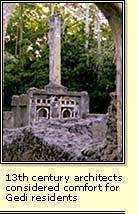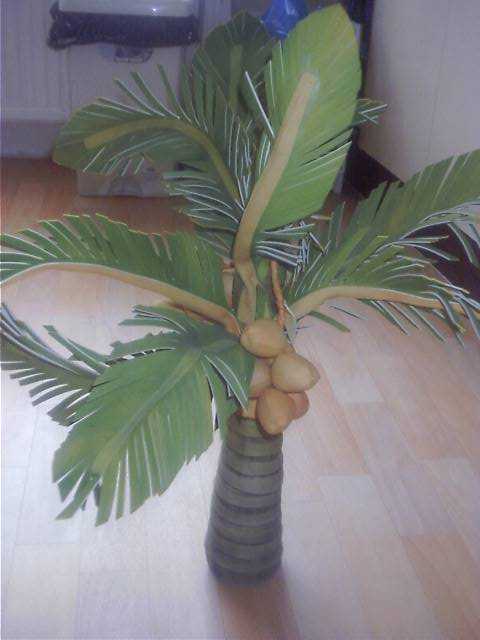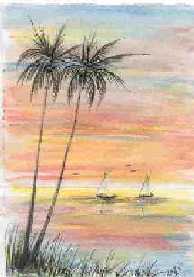
The Waswahili Community Trust UK
(Wadhamini wa jumuiya ya Waswahili)


|
The Waswahili Community Trust UK |
 |

One has to understand the ecology of the Lamu Archipelago to understand its rigours. A hardy environment builds a hardy people. A hardy people are a people who are not only prepared to work hard but they have to apply every physical and mental sinew to the survival game. If one were to hazard a guess, one would say that about 75-80% of a traditional Mswahili's life is based on the sea.
The rest of the time, his life is occupied with essentially terrestrial pursuits. In short, farming. To the Swahilis, farming is a mixture of perennials and seasonal food plants. The principal perennials have traditionally been the coconut, mango and cashewnut trees. The coconut tree is intimately connected with the Swahili way of life throughout Swahililand.
It is said that there are at least one hundred uses to which the Swahilis make use of the coconut palm. We shall make no attempt to itemize these uses. Suffice it to say that the coconut palm provides food, drink, shelter, oils, building materials, rope, fuel and a host of other products richly connected with what one might call 'the Swahili way of life'.
One has to live in a Swahili home to appreciate this even partially. If you get an invitation for a meal with your Swahili friends, you might hint that a truly Swahili meal would be deeply appreciated.
Coconut farming is not, contrary to popular upcountry mythology, a matter of sitting under the coconut tree and waiting a coconut to fall. It is much more than that. The planting is an art and a science. The protection is an art and a science. The husbandry is an art and a science. The watering is an art and a science.
Once mature the uses to which the coconut tree is put calls for different skills and timings. Some farmers specialize in tapping sweet sap that is used as a common source of pastry leavening and also for making coconut vinegar or a refreshing drink concentrate known as ngizi. For non-Muslims, the sweet toddy is a source of fermentation to make alcohol and subsequent inebriation. But for Muslims and non-Muslims, the alcohol could provide a local gasohol ingredient of significance.
We must resist the temptation of going through the long strings of interplay between the Swahilis and the coconut palm. It would be a fitting subject of a complete lecture on its own. Some of the extreme conditions of farming are found in the Lamu Archipelago Windward Islands. These islands suffer from chronic infertility and water scarcity makes farming pretty nearly impossible. The scarce water is very highly prized.
The short rains are extremely unreliable in these climes and the vegetation is inevitably sparse. One or two months' rains during May and June probably provide all the moisture for man, beast and plants. The Bajunis (and indeed, throughout the Swahili world) the technology of sustenance is provided by the jabiya - the underground covered water preservation tank system which ensures maximum catchment of virtually every drop of rain water.
Whatever evaporation there might be would condense on the inclined roof and drip back into the main water body. More often than not the inhabitants of these isles understand all too acutely that the catchment of the May-June rain might be called upon to provide water to the entire community throughout the rest of the year. This, as we have stressed, is due to the general unreliability of the short rains.
But the Bajunis not only occupy these islands but also the adjoining mainland. Of late, heavily armed bandits have infiltrated these adjoining mainland areas and agricultural pursuit is one aspect of Bajuni life that is getting severely impaired. The islands are largely infertile and with very little water. The rains do come during the long rains stretching from April to June but the rainfall is very sporadic, coming often in torrential bursts for one to two months and thereafter -- nothing. But we will come back to that a little later.
For the moment, we must note that farming is really a non-starter in most of these Lamu Archipelago Windward Islands occupied by the Bajunis. On the mainland, the situation is quite different. The land is fertile and generally wooded. The rainfall is relatively generous and, even more importantly, spread out for crop farming. Even then, in some parts of the same Bajuni mainland, the farming is really what we might call dryland farming. The principal crops of the area are sorghum and millet.
Sorghum and millet are the indigenous African cereals, unlike maize that was imported from America. At the risk of a little diversion, not many people (Africans, in particular) realize that some of the food crops they have taken for granted to be of ancient African origins, are, in fact, American.
These include maize, manioc (or, as we normally know it, cassava), sweet potatoes, peanuts and beans. Slave ships from Brazil (the only Portuguese colony in Latin America) found that these crops not only did well in Africa but also provided important additives to the indigenous African crops like sorghum and millet. Cassava in particular proved highly resistant to locusts and presented little or no storage problems provided of course one could deal with wild pigs!
But a visit to Kiunga and some of the mainland Bajuni areas would be instructive in that it will reveal some of the indigenous Coastal Swahili farming methods and technology. The biggest pests in sorghum farming are the seed-eating birds such as quelea. Special structures are built by Bajuni farmers where watches can be carried out throughout the day from a high platform with a straw top for protecting the bird watcher by providing some shade relief from the fierce sun.
One of the skills that the watchman has to have is that of being an excellent slingshot to chase away flocks of these menacing birds. One has to see these slings shots to appreciate the degree of skill required. Of course, one of the pursuits of Bajuni young men is to learn these techniques in the early years.
Every farmer worth his salt understands the delicate interaction between four basic elements: weather, soil, seed and pests. Farming is not a hit-and-run occasional pursuit. It is often a matter of life and death for a community. The Bajuni farmers needed to provide an essential complement of carbohydrates and vegetable proteins to the generous marine resources that have constituted the mainstay of the Swahili nutritional base.
To reverse a metaphor, to the Swahilis it is not a matter of Man does not live by bread alone, it is rather that Man does not live by fish alone. The Swahilis as a whole have never really distinguished themselves as livestock farmers. Neighbouring pastorals generally provided the bulk of the animals and animal products to the Swahilis. These pastoral neighbours included the Somalis, the Gallas, the Garbatullas and the like.

We appeal for your donation for our charity
Comments and suggestions to improve this website
Your suggestions or concerns about our services
Please send you contributions using form to contact us.
| Thank you Asanteni |
|---|
Copyright© March 2003: The Waswahili Community Trust (UK)
Registered Charity:1083065